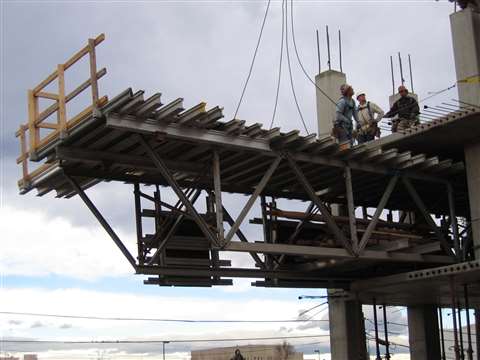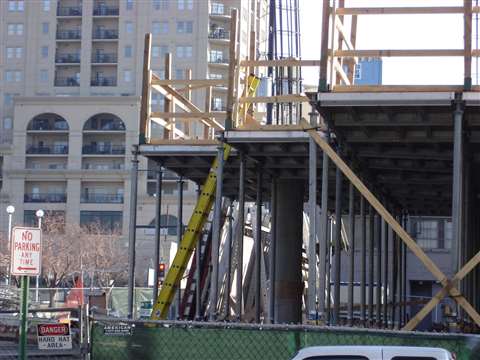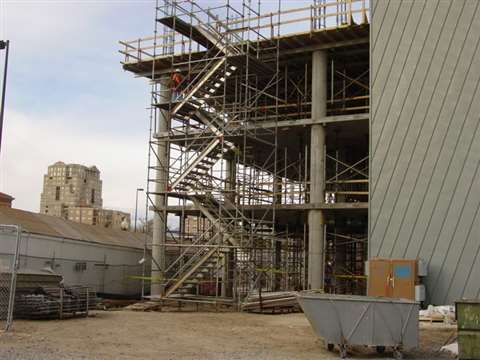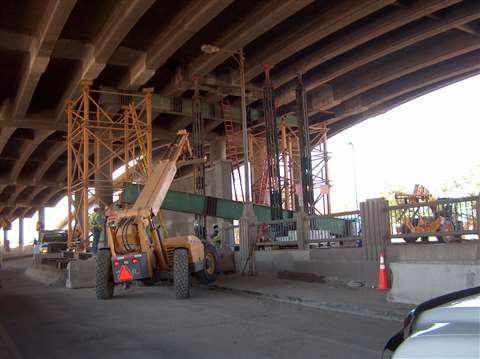Scaffolding and shoring: What’s the difference?
09 March 2023
A tricky process it is to ensure that your shoring project is in compliance with the regulations promulgated by the United States Occupational Safety and Health Administration, OSHA. More specifically, proper application of the fall protection and access regulations requires care and skill because of the difficult and awkward nature of the regulations.
In other words, it can get tricky. That trickiness can be attributed to the apparent confusion that some individuals have regarding the relationship between scaffolding and shoring. Therefore, before even attempting to determine regulatory compliance, it is necessary to ascertain whether the equipment you are using is scaffolding or shoring. If you do not do that first, you will never be able to correctly apply the applicable regulations.
So, what is the difference between scaffolding and shoring? It is important to know this since there are separate fall protection and access regulations for scaffolding and shoring. As defined by OSHA, a scaffold is any temporary elevated platform and it’s supporting structure, used for supporting employees or materials or both.
Shoring, on the other hand, is temporary equipment that is used to support an existing structure or is used to support concrete formwork and concrete. While both have platforms, the purpose of the platform defines its usage.

Shoring decks are not platforms
A scaffold platform is used to support workers at elevated locations while a shoring platform, or deck, is used to support concrete. Although it is true that workers will be standing on these platforms and decks, the worker on a scaffold is doing work from the platform; on a shoring deck, the worker is doing work to the deck. In fact, a shoring deck really isn’t a platform, but rather it is a walking/working surface. This is important to know since this distinction determines which regulations apply to a specific situation.
For scaffolding, the fall protection regulations are found in Subpart L – Scaffolding, of the OSHA Construction Industry Regulations. For shoring, the fall protection regulations are found in subpart M – Fall Protection, of the OSHA Construction Industry Regulations. So far, so good, but here is where it starts to get tricky for shoring.
First, for shoring operations, fall protection is required once the worker is 6 feet above the surface below as opposed to 10 feet for scaffold applications. This is the federal OSHA requirement. Certain states, such as California and Washington, the height threshold varies anywhere between 4 feet and 10 feet, depending on the work being done.
Since OSHA has opined that the various components of a shoring system are walking/working surfaces, it complicates when fall protection is required. Unlike a scaffold platform where fall protection, either a guardrail system or a personal fall arrest system, is only required on all open sides and ends of a platform, a shoring installation requires fall protection on not only the deck, but also the shoring frames, joists and stringers that are typical components of a shoring system.
 An example of “flying” formwork. (Photo: David Glabe)
An example of “flying” formwork. (Photo: David Glabe)
Fall protection complications
Even the fall protection on the deck can be problematic while it is being constructed. It is expected that the deck will be protected, typically by a guardrail system on the completed portions of the deck, and by the installation of personal fall arrest systems at the leading edge of the deck, that is the edge that keeps moving as the deck is constructed. While the worker is climbing the shoring frames, personal fall arrest is required since the frames are considered to be walking/working surfaces. The same holds true while standing on joists and stringers.
What about the perimeter of the shoring deck? This portion of the deck is typically used solely for the workers who are placing concrete. This would suggest that this portion of the deck is actually a scaffold platform. I dare say do not go down this road. Since the majority of the deck is used to support concrete, consider all of it, including the perimeter, a walking working surface and therefore the subpart M fall protection requirements apply.
Here are a few other differences between scaffold fall protection and shoring fall protection of which you should be aware. A scaffold top rail height is between 38 and 45 inches while a shoring top rail height is between 39 and 45 inches.
A scaffold top rail must support 200 pounds in any downward or horizontal direction while a shoring top rail must support 200 pounds in any downward or outward direction.
Additional considerations on the jobsite
Crossbraces can be used as part of a guardrail system on scaffolding, but not on shoring. And, as previously mentioned, fall protection is required when the scaffold platform is more than 10 feet above the level below while fall protection is required when the shoring deck is 6 feet or more above the level below.
 Shoring ladder access. (Photo: David Glabe)
Shoring ladder access. (Photo: David Glabe)
Access offers its own complexity. Access for shoring must comply exclusively with the regulations of Subpart X of the OSHA Construction Industry Regulations, while access for scaffolding must comply with either Subpart L (Scaffolds) or subpart X (Stairs and Ladders,) depending upon the type of access being utilized.
 Construction stairways. (Photo: David Glabe)
Construction stairways. (Photo: David Glabe)
 Extension ladders on a jobsite. (Photo: David Glabe)
Extension ladders on a jobsite. (Photo: David Glabe)
For example, if an extension ladder is being used to access a scaffold platform, it must comply with subpart X. The same holds true for shoring. Scaffold users can use purpose design scaffold frames for access, while shoring frames, which may look like ladders, cannot be used for access without utilizing personal fall arrest systems because they are considered walking working surfaces.
Subparts and quirks
Interestingly, if a stair tower constructed of scaffold components is used to access a shoring deck, it is no longer a scaffold stairway but rather a construction stairway and therefore must comply with subpart X. Here, the significant difference between Subpart L and Subpart X regarding access is that the first step in a shoring application can be no more than 19 inches while in a scaffold application the first step can be no more than 24 inches. There are a few other quirks. For example, direct access from a scaffold platform to another surface is addressed in Subpart L, but Subpart M is silent on the matter.
It is obvious that it should not be assumed that the scaffold fall protection requirements are the same as those for shoring. Neither should one assume that the access requirements are the same. It is clear that fall protection and access requirements should not be left to the novice but rather, these decisions should be left to those who have had the training to understand the nuances of the various regulations.
It can be tricky.
CONNECT WITH THE TEAM




